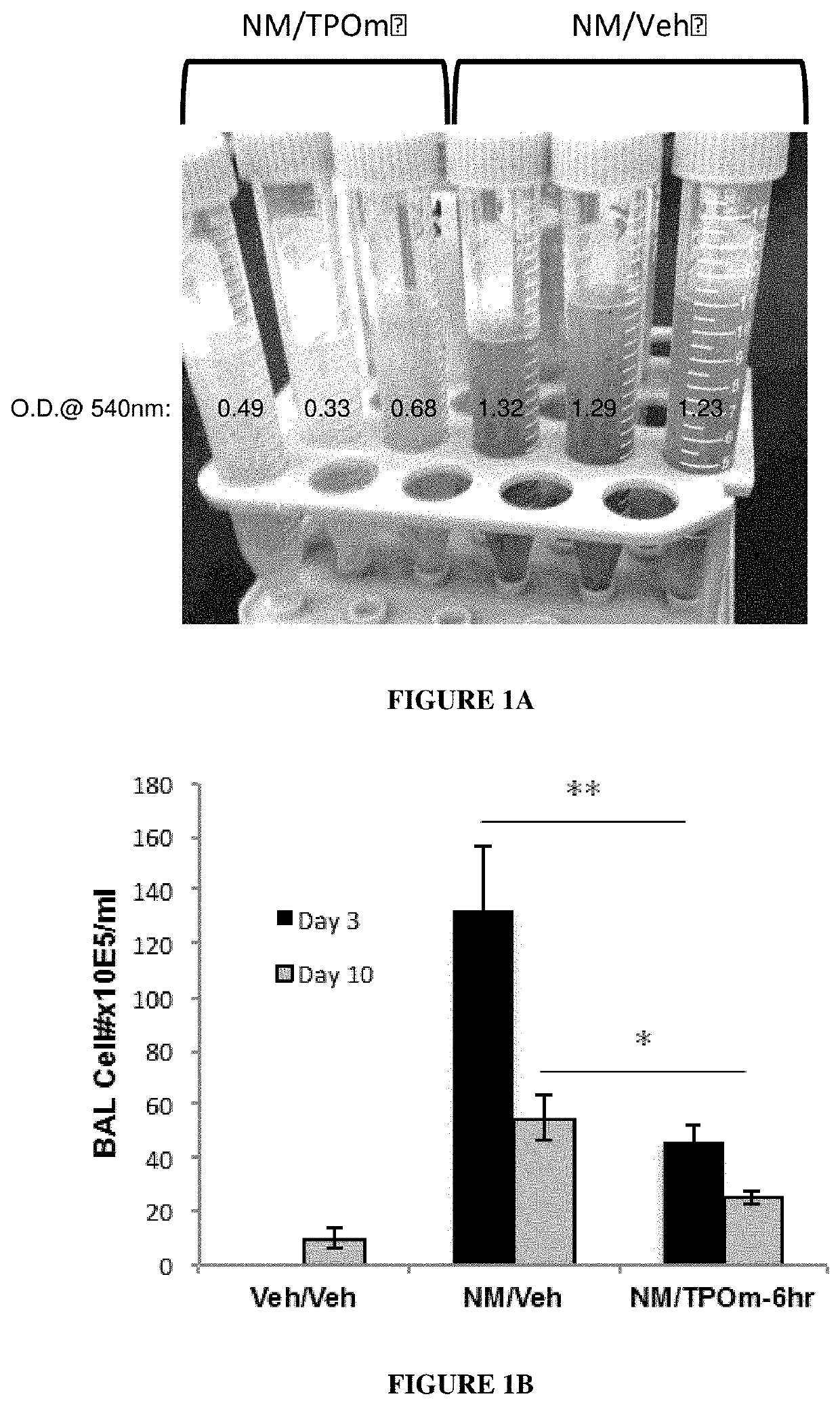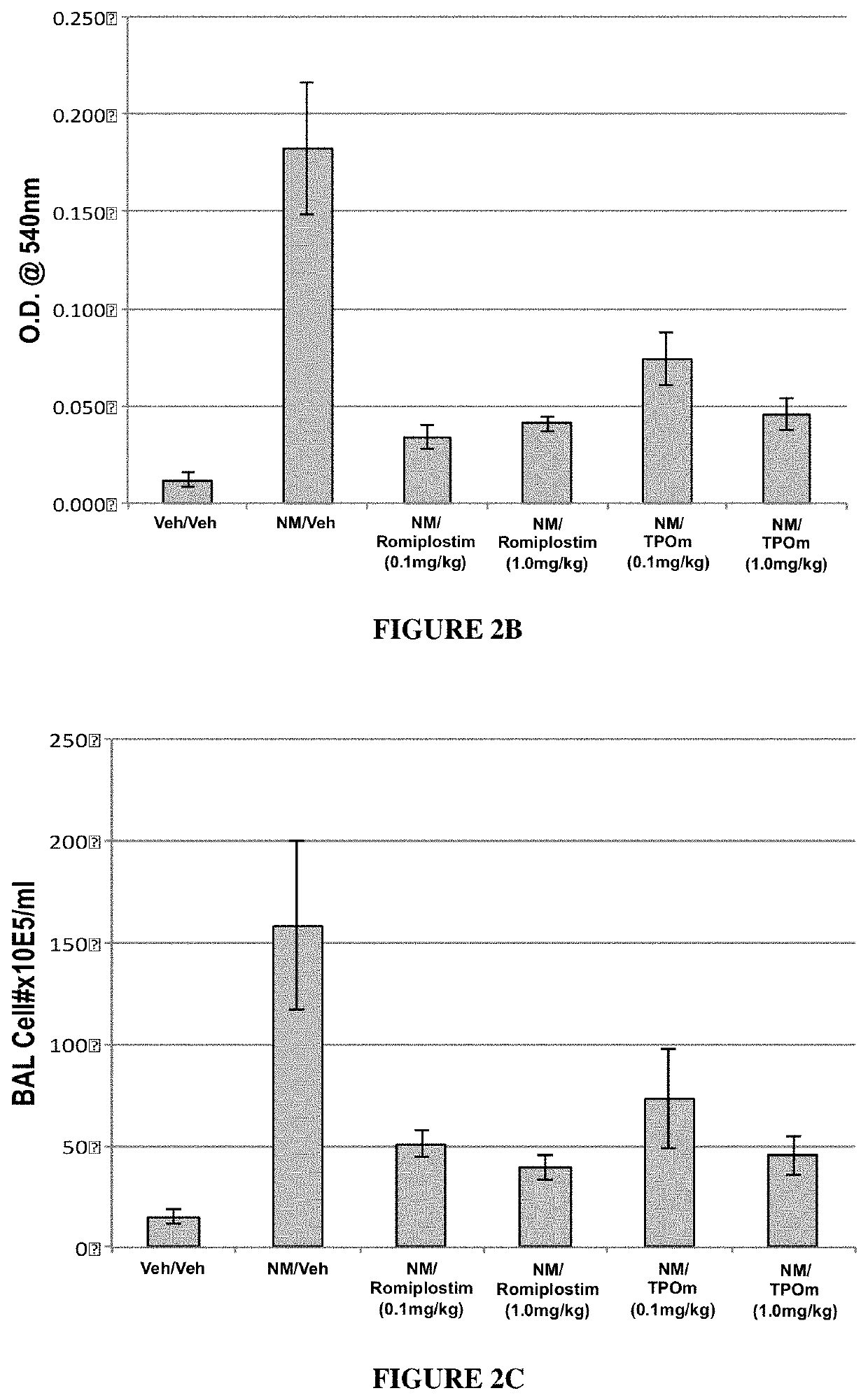Methods of mitigating toxic effects of vesicants and caustic gas
a technology of caustic gas and vesicants, which is applied in the direction of antinoxious agents, drug compositions, peptide/protein ingredients, etc., can solve the problems of increasing the likelihood of use by radical groups conducting terror attacks on the homeland and battlefield, low technical skill and inexpensive reagents and equipment, and reducing the severity and number of micro-hemorrhage sites. , the effect of preventing severe vascular damag
- Summary
- Abstract
- Description
- Claims
- Application Information
AI Technical Summary
Benefits of technology
Problems solved by technology
Method used
Image
Examples
example 1
TPOm on NM-induced Lung Injury
[0142]Materials and Methods
[0143]Animals: Male Wistar rats (300-320 grams) were divided into 2 groups: NM / Veh, and NM / TPOm.
[0144]Nitrogen Mustard Exposure: In this study, mechlorethamine, a non-gaseous Nitrogen Mustard (NM), was used as a surrogate for sulfur mustard, to facilitate the exposure of laboratory animals to a vesicant agent and to reduce hazards to researchers. It is expected that information gained in these studies using NM can be directly applied to guide the design and define the endpoints of interest in proposed studies involving exposures of sulfur mustard gas. In particular, groups of male Wistar rats (300-320 grams) received 0.125 mg / kg of the sulfur mustard surrogate, mechlorethamine, via tracheal instillation on day 0.
[0145]TPOm synthesis and treatments: TPOm was synthesized by Janssen Pharmaceuticals as described previously (see, e.g., U.S. Pat. No. 7,576,056). TPOm was reconstituted in sterile saline, sterile filtered, aliquoted, ...
example 2
TPOm on NM-Induced Pulmonary Fibrosis at Days 42 and / or 70
[0156]Materials and Methods
[0157]Animals. Male Wistar rats (300-320 grams) were divided into 2 groups: NM / Veh, and NM / TPOm.
[0158]Nitrogen Mustard Exposure: In this study, groups of male Wistar rats received 0.125 mg / kg of the sulfur mustard surrogate, mechlorethamine, via tracheal instillation on day 0.
[0159]TPOm synthesis and treatments: TPOm was synthesized by Janssen Pharmaceuticals as described previously (see, e.g., U.S. Pat. No. 7,576,056). TPOm was reconstituted in sterile saline, sterile filtered, aliquoted, and stored at −20 C until use. In this extended study examining the effect of TPOm on the development of lung fibrosis out to Day 70, rats received multiple doses of TPOm (0.3 mg / kg) administered at two different dose-timing schedules (6 h, 6 h & day 7 vs. 6 h, day 7 & day 14) following treatment with the NM vesicant.
[0160]Magnetic resonance imaging (MRI) measurements: MRI was conducted periodically throughout an ...
example 3
TPOm on NM-Induced Mortality
[0163]Materials and Methods
[0164]Animals. Male Wistar rats (300-320 grams) were divided into 2 groups: NM / Veh, and NM / TPOm.
[0165]Nitrogen Mustard Exposure: A series of preliminary studies was conducted to determine the dose range of NM resulting in the mortality of Wistar rats within a 2-week period. And the results of these studies showed an exceedingly steep NM dose response for animal death with the LD50-LD70 projected between 1.23 & 3.75 mg / kg. Based on the severity of systemic observations in these range-finding studies, the dose of 1.7 mg / kg NM was selected for subsequent studies examining the effect of TPOm on NM-induced mortality. In this study, groups of male Wistar rats (10 / group) were treated with a dose of NM projected to be the LD50, 1.7 mg / kg of the sulfur mustard surrogate, mechlorethamine, via tracheal instillation on day 0. Animals were then returned to normal shoebox housing, weighed daily and observed frequently throughout the study per...
PUM
| Property | Measurement | Unit |
|---|---|---|
| volume | aaaaa | aaaaa |
| volume | aaaaa | aaaaa |
| weight loss | aaaaa | aaaaa |
Abstract
Description
Claims
Application Information
 Login to View More
Login to View More - R&D
- Intellectual Property
- Life Sciences
- Materials
- Tech Scout
- Unparalleled Data Quality
- Higher Quality Content
- 60% Fewer Hallucinations
Browse by: Latest US Patents, China's latest patents, Technical Efficacy Thesaurus, Application Domain, Technology Topic, Popular Technical Reports.
© 2025 PatSnap. All rights reserved.Legal|Privacy policy|Modern Slavery Act Transparency Statement|Sitemap|About US| Contact US: help@patsnap.com



